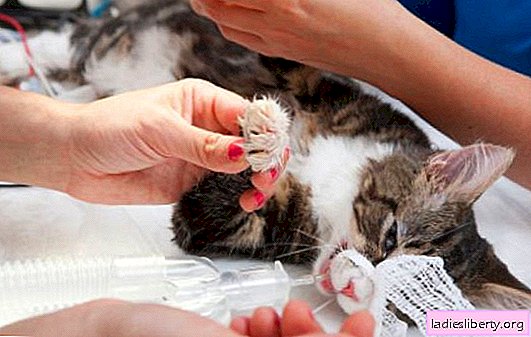
Many forums are full of screaming headlines: "Leukemia in cats is a deadly disease!". In fact, everything is a little different. The disease is really dangerous. In fact, it is a chronic oncological disease, and there is nothing worse than oncology. But, according to statistics, the survival rate among patients with the FeLV virus is more than 50%.
Firstly, leukemia has several forms, so it’s pointless to say that a cat will die. It all depends on the immunity of the pet. Secondly, if you contact a qualified specialist in a timely manner, the chances of extending the life of your furry pet increase. Therefore, do not rush to panic.
Ways to catch a cat leukemia
The greatest risk factor includes cats of any breed and age. Cats suffer from leukemia much less often. Consider how an animal can become infected with leukemia:
· Transmitted from cat to cat by airborne droplets;
· Contactless infection. The virus "wakes up" in the body of the pet, without contact with infectious animals;
· Through the bites of bloodsucking (mosquitoes, ticks and others). In the event that the insect has bitten a sick animal, and then healthy;
· Also, the virus is transmitted through hygiene items (combs, claws, etc.), as a rule, infection occurs at exhibitions;
· Through the blood. The virus enters the body of an animal through wounds, for example, during a fight;
· Newborn kittens become infected in utero or through mother’s milk.
Is leukemia in cats dangerous for humans?
If you are concerned about the danger of the virus to humans. We hasten to reassure - the virus is not dangerous for people, even with very close and long contact with a sick pet. This fact has been proved with the help of scientific research in both Russian and foreign clinics.
Symptoms of Leukemia in Cats
The virus infects the immune system, lymphatic and circulatory. All other organs receive a “blow” due to a complication of leukemia. Symptoms of the disease are as follows:
· Frequent, sudden rises in body temperature;
· Loss of activity;
· Complete refusal of food;
· Rapid exhaustion;
· Frequent problems with the gastrointestinal tract (constipation or diarrhea);
· The mucous membranes become pale (yellowish);
· Lymph nodes, kidneys and liver increase (noticeably upon palpation);
· Often excessive salivation;
· The animal often colds (cough, runny nose, possibly discharge from the eyes join);
· There is a bulging eye;
Malfunctions of the heart (arrhythmia, tachycardia);
· Increased drowsiness, depression.
Important! Remember, to increase the chance of curing your beloved pet, you should immediately contact your veterinarian if you notice suspicious symptoms.
Forms of Leukemia in Cats
There are several forms of leukemia in cats:
1. Transient. The probability of survival is very high. The decisive role is played by the immunity of the animal. The stronger it is, the greater the chance of survival. The cat's body is able to overcome the virus itself;
2. Latent. It affects the kidneys, liver and lymph nodes. With proper prescription of drugs and with proper maintenance, the animal can live with this disease for many years;
3. Persistent. The most dangerous form that is not treatable. The pet often starts to get sick, secondary infections join, the animal weakens and dies. This is due to a weakening of the immune system.
Methods for diagnosing leukemia in cats
In the early stages of the disease, a visual examination cannot be made. It is beyond the power of even a highly qualified specialist. To identify the disease, a sufficiently significant series of procedures is necessary:
· Blood chemistry;
· PCR method (this analysis allows you to quickly and almost accurately detect many different viruses and infections);
· Ultrasound and radiography;
· Histological examination (based on the study of a tissue sample from the animal’s body);
Enzyme-linked immunosorbent assay (detection of viruses in the blood using biochemical reactions);
· If these tests are not enough, then a biopsy and other specific studies are prescribed.
The most common diagnosis is an express test. To determine the disease, you need to do two tests, one will not be enough. Do not rush to be upset if the first study shows the presence of the virus. Tests often provide false information, and their results are not fundamental to making an accurate diagnosis.
Treatment for Leukemia in Cats
Unfortunately, to date, no effective remedy for this disease has been found. The veterinarian can only prescribe therapy to eliminate the symptoms based on the condition of the cat. As a rule, appoint:
· Antibiotics;
· Drugs that support the immune system;
· In some cases, drugs intended to treat HIV infection in people may be prescribed;
Symptomatic therapy (drugs for the common cold, discharge from the eyes, diarrhea, constipation, etc.);
In the case of a severe form, the doctor may prescribe chemotherapy or a blood transfusion.
Cat Leukemia Prevention
To protect your cat as much as possible from encountering the disease, the following preventive measures are recommended:
· Although the vaccine is not a 100% guarantee that the cat will not get leukemia, it significantly reduces the risk. Therefore, it is necessary to do complex vaccinations against viral diseases, including leukemia. The most popular vaccine to date is Purevax FeLV;
· Infection can be brought home on the soles of shoes. Therefore, before entering the room, wipe the shoes or clean them in a place inaccessible to the pet;
· Frequently handle the toilet tray with special disinfectants;
· Protect your cat from free walking to avoid the risk of infection from street animals;
· Do not let your pet get cold. Colds can trigger the development of leukemia;
· The most important thing is the support of immunity. The diet should be balanced, rich in proteins and vitamins;
· If the animal attends the exhibition, use only your hairbrushes, claws and more;
In case of suspicion of a cold or other infection, do not delay the visit to the doctor. Self-medication is dangerous and can lead to irreversible consequences, including leukemia.
If your pet is diagnosed, do not rush to refuse a furry friend, putting him to sleep. With the correct appointment of a doctor and in the case of strong immunity, the animal can live long and happy years near you. The main thing is not to lose heart, strictly adhere to the recommendations of specialists, and provide your pet with a favorable atmosphere.











